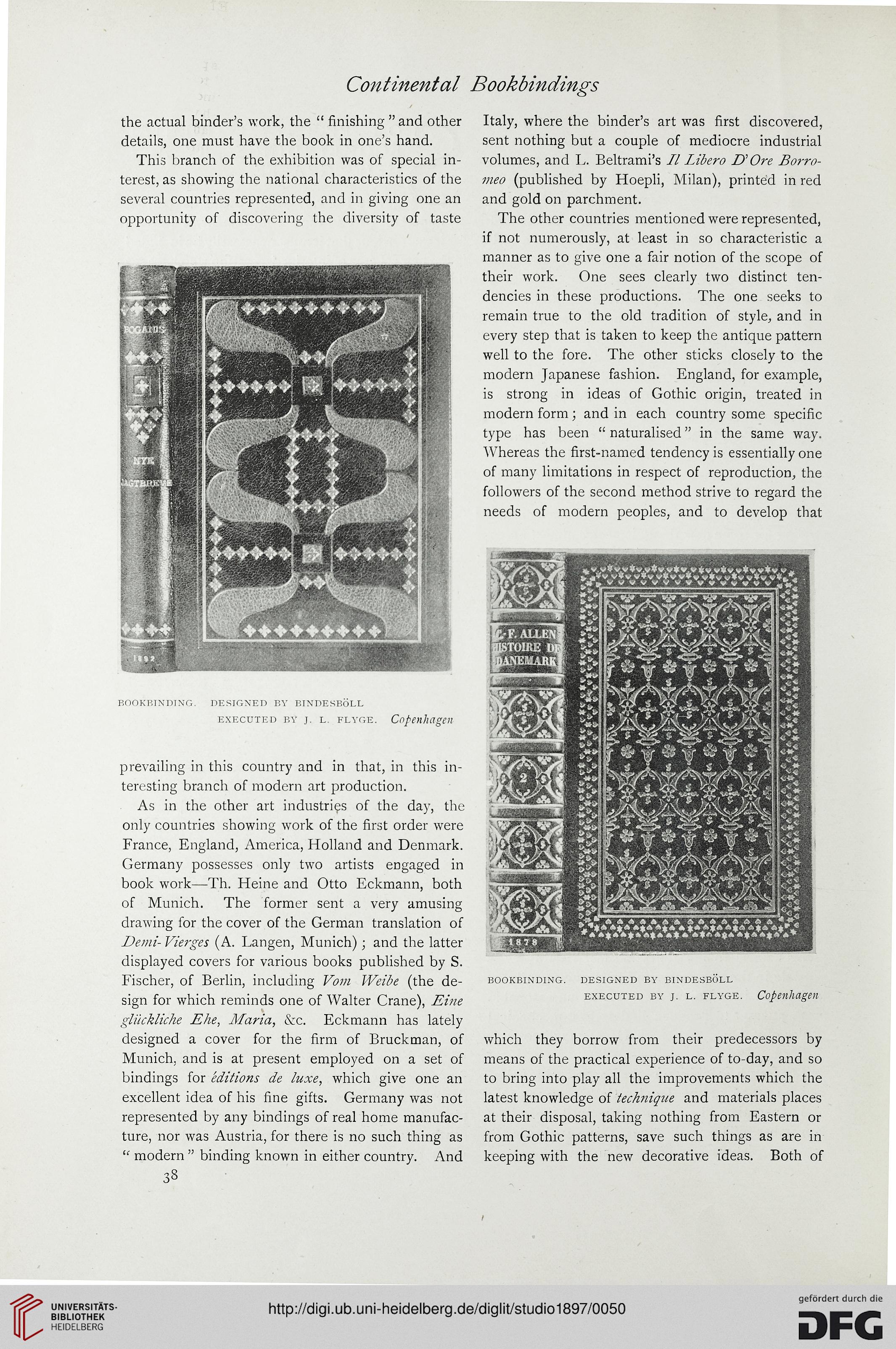Continental
the actual binder's work, the " finishing " and other
details, one must have the book in one's hand.
This branch of the exhibition was of special in-
terest, as showing the national characteristics of the
several countries represented, and in giving one an
opportunity of discovering the diversity of taste
bookbinding. designed by bindesboll
executed by j. l. flyge. Copenhagen
prevailing in this country and in that, in this in-
teresting branch of modern art production.
As in the other art industries of the day, the
only countries showing work of the first order were
France, England, America, Holland and Denmark.
Germany possesses only two artists engaged in
book work—Th. Heine and Otto Eckmann, both
of Munich. The former sent a very amusing
drawing for the cover of the German translation of
Demi- Vierges (A. Langen, Munich); and the latter
displayed covers for various books published by S.
Fischer, of Berlin, including Vom Weibe (the de-
sign for which reminds one of Walter Crane), Eine
gliickliche Ehe, Maria, &c. Eckmann has lately
designed a cover for the firm of Bruckman, of
Munich, and is at present employed on a set of
bindings for editions de luxe, which give one an
excellent idea of his fine gifts. Germany was not
represented by any bindings of real home manufac-
ture, nor was Austria, for there is no such thing as
" modern " binding known in either country. And
38
Bookbindings
Italy, where the binder's art was first discovered,
sent nothing but a couple of mediocre industrial
volumes, and L. Beltrami's // Libero UOre Borro-
meo (published by Hoepli, Milan), printed in red
and gold on parchment.
The other countries mentioned were represented,
if not numerously, at least in so characteristic a
manner as to give one a fair notion of the scope of
their work. One sees clearly two distinct ten-
dencies in these productions. The one seeks to
remain true to the old tradition of style, and in
every step that is taken to keep the antique pattern
well to the fore. The other sticks closely to the
modern Japanese fashion. England, for example,
is strong in ideas of Gothic origin, treated in
modern form; and in each country some specific
type has been " naturalised" in the same way.
Whereas the first-named tendency is essentially one
of many limitations in respect of reproduction, the
followers of the second method strive to regard the
needs of modern peoples, and to develop that
bookbinding. designed by bindesboll
executed by j. l. flyge. Copenhagen
which they borrow from their predecessors by
means of the practical experience of to-day, and so
to bring into play all the improvements which the
latest knowledge of tech?iique and materials places
at their disposal, taking nothing from Eastern or
from Gothic patterns, save such things as are in
keeping with the new decorative ideas. Both of
the actual binder's work, the " finishing " and other
details, one must have the book in one's hand.
This branch of the exhibition was of special in-
terest, as showing the national characteristics of the
several countries represented, and in giving one an
opportunity of discovering the diversity of taste
bookbinding. designed by bindesboll
executed by j. l. flyge. Copenhagen
prevailing in this country and in that, in this in-
teresting branch of modern art production.
As in the other art industries of the day, the
only countries showing work of the first order were
France, England, America, Holland and Denmark.
Germany possesses only two artists engaged in
book work—Th. Heine and Otto Eckmann, both
of Munich. The former sent a very amusing
drawing for the cover of the German translation of
Demi- Vierges (A. Langen, Munich); and the latter
displayed covers for various books published by S.
Fischer, of Berlin, including Vom Weibe (the de-
sign for which reminds one of Walter Crane), Eine
gliickliche Ehe, Maria, &c. Eckmann has lately
designed a cover for the firm of Bruckman, of
Munich, and is at present employed on a set of
bindings for editions de luxe, which give one an
excellent idea of his fine gifts. Germany was not
represented by any bindings of real home manufac-
ture, nor was Austria, for there is no such thing as
" modern " binding known in either country. And
38
Bookbindings
Italy, where the binder's art was first discovered,
sent nothing but a couple of mediocre industrial
volumes, and L. Beltrami's // Libero UOre Borro-
meo (published by Hoepli, Milan), printed in red
and gold on parchment.
The other countries mentioned were represented,
if not numerously, at least in so characteristic a
manner as to give one a fair notion of the scope of
their work. One sees clearly two distinct ten-
dencies in these productions. The one seeks to
remain true to the old tradition of style, and in
every step that is taken to keep the antique pattern
well to the fore. The other sticks closely to the
modern Japanese fashion. England, for example,
is strong in ideas of Gothic origin, treated in
modern form; and in each country some specific
type has been " naturalised" in the same way.
Whereas the first-named tendency is essentially one
of many limitations in respect of reproduction, the
followers of the second method strive to regard the
needs of modern peoples, and to develop that
bookbinding. designed by bindesboll
executed by j. l. flyge. Copenhagen
which they borrow from their predecessors by
means of the practical experience of to-day, and so
to bring into play all the improvements which the
latest knowledge of tech?iique and materials places
at their disposal, taking nothing from Eastern or
from Gothic patterns, save such things as are in
keeping with the new decorative ideas. Both of




